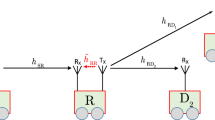Abstract
In this paper, we investigate a dual-hop decode-and-forward (DF) relaying vehicular system in the presence of co-channel interference, in which source, relay and destination terminals are composed of vehicles and interferers are stationary. Independently but not necessarily identically distributed (i.n.i.d.) cascaded Nakagami-m fading is adopted to characterize the vehicle-to-vehicle channel. Novel closed-form expressions are derived for cumulative distribution function (CDF) of end-to-end signal-to-interference-plus-noise-ratio at the relay and the destination. By using CDF expressions, we have analyzed the performance of dual-hop DF relaying vehicular systems in terms of outage probability and average symbol error probability. Then, we have calculated the upper bounds of outage probability and symbol error probability expressions for high signal-to-noise ratio. Lastly, the effect of relay geometry on system performance has been examined. The proposed mathematical analyses have been verified through the Monte-Carlo simulations.






Similar content being viewed by others
References
Laneman, J. N., Tse, D., & Wornell, G. (2004). Cooperative diversity in wireless networks: Efficient protocols and outage behaviour. IEEE Transactions on Information Theory, 50, 3062–3080.
Hasna, M. O., & Alouini, M. S. (2004). A performance study of dual-hop transmissions with fixed gain relays. IEEE Transactions on Communications, 3, 1963–1968.
Milosevic, B., Spalevic, P., Petrovic, M., Vuckovic, D., & Milosavljevic, S. (2009). Statistics of macro SC diversity system with micro EGC diversity systems and fast fading. Electronics and Electrical Engineering–Kaunas: Technologija, 8(96), 55–58.
Petrovic, I., Stefanovic, M., Anastasov, J., Panic, S., Djordjevic, G., & Millic, D. (2010). Outage probability of SSC receivers in correlated Rayleigh fading channel with multiple co-channel interferers. Electronics and Electrical Engineering–Kaunas: Technologija, 10(106), 67–70.
Krikidis, I., Thompson, J., Mclaughlin, S., & Goertz, N. (2009). Max–min relay selection for legacy amplify-and-forward systems with interference. IEEE Transactions on Wireless Communications, 8, 3016–3027.
Zhong, C., Jin, S., & Wong, K. K. (2010). Dual-hop systems with noisy relay and interference-limited destination. IEEE Transactions on Communications, 58, 764–768.
Suraweera, H. A., Garg, H. K., & Nallanathan, A. (2010). Performance analysis of two-hop amplify-and-forward systems with interference at the relay. IEEE Communications Letters, 14, 692–694.
da Costa, D. B., & Yacoub, M. D. (2011). Outage performance of two hop AF relaying systems with co-channel interferers over Nakagami-m fading. IEEE Communications Letters, 15, 980–982.
da Costa, D. B., Ding, H., & Ge, J. (2011). Interference-limited relaying transmissions in dual-hop cooperative networks over Nakagami-m fading. IEEE Communications Letters, 15, 503–505.
Yu, H., Lee, I. H., & Stüber, G. L. (2012). Outage probability of decode-and-forward cooperative relaying systems with co-channel interference. IEEE Transactions on Wireless Communications, 11, 266–274.
Al-Qahtani, F. S., Yang, J., Radaydeh, R. M., & Alnuweiri, H. (2013). On the capacity of two-hop AF relaying in the presence of interference under Nakagami-m fading. IEEE Communications Letters, 17, 19–22.
Suraweera, N., & Beaulieu, N. C. (2013). Outage probability of decode-and-forward relaying with optimum combining in the presence of c-channel interference and Nakagami fading. IEEE Transactions on Wireless Communications, 2, 495–498.
Kovacs, I. Z. (2002). Radio channel characterization for private mobile radio systems: Mobile-to-mobile radio link investigations, Ph.D. Thesis, Aalborg University.
Andersen, J. B. (2002). Statistical distributions in mobile communications using multiple scattering. In URSI General Assembly Proceedings, Session CBF.
Chen, Y., Karagiannidis, G. K., Lu, H., & Cao, N. (2012). Novel approximations to the statistics of products of independant random variables and their applications in wireless communications. IEEE Transactions on Vehicular Technology, 61, 443–454.
Salo, J., El-Sallabi, H., & Vainikainen, P. (2006). The distribution of the product of independent Rayleigh random variables. IEEE Transactions on Antennas and Propagation, 54, 639–643.
Erceg, V., Fortune, S. J., Ling, J., Rustako, A., & Valenzuela, R. (1997). Comparisons of computer-based propagation prediction tool with experimental data collected in urban microcellular environments. IEEE Journal on Selected Areas in Communications, 15, 677–684.
Uysal, M. (2005). Maximum achievable diversity order for cascaded Rayleigh fading channels. IET Electronics Letter, 41, 1289–1290.
Tirkan, Z., Shirkhani, M., Taherpour, A., & Uysal, M. (2012). Performance of cooperative amplify-and-forward protocols in vehicular ad-hoc networks. In IEEE WCSP (pp. 1–6).
Karagiannidis, G. K., Sagias, N. C., & Mathiopoulos, P. T. (2007). N*Nakagami: A novel stochastic model for cascaded fading channels. IEEE Transactions on Communications, 55, 1453–1458.
Ahmed, S., Yang, L. L., & Hanzo, L. (2011). Probability ditributions of products of Rayleigh and Nakagami-m variables using Mellin transform. In IEEE ICC (pp. 1–5).
Shankar, P. M. (2011). Performance of N*Nakagami cascaded fading channels in dual selection combining diversity. In 7th International wireless communications and mobile computing conference (IWCMC) (pp. 1539–1544).
Zheng, Z., Wei, L., & Hamalainen, J. (2013). Novel approximations to the statistics of general cascaded Nakagami-m channels and their applications in performance analysis. In IEEE ICC.
Ilhan, H., Uysal, M., & Altunbas, I. (2009). Cooperative diversity for inter-vehicular communication: Performance analysis and optimization. IEEE Transactions on Vehicular Technology, 58(7), 3301–3310.
Sagias, N. C., & Tombras, G. S. (2007). On the cascaded Weibull fading channel model. Journal of the Franklin Institute, 344, 1–11.
Trigui, I., Laourine, A., Affes, S., & Stephenne, A. (2009). On the performance of cascaded generalized K fading channels. In IEEE GLOBECOM (pp. 1–5).
Ilhan, H. (2012). Performance analysis of two-way AF relaying systems over cascaded Nakagami-m fading channels. IEEE Signal Processing Letters, 19, 332–335.
Filho, J. C. S. S., & Yacoub, M. D. (2004). Nakagami-m approximation to the sum of M non-identical independent Nakagami-m variates. IET Electronics Letters, 40, 951–952.
Gradshteyn, I. S., & Ryzhik, M. I. (2007). Table of integrals, series and products (7th ed.). London: Academic Press.
Bateman, H. (1954). Table of integral transforms (Vol. II). New York: McGraw-Hill.
Simon, M. K., & Alouini, M. S. (2005). Digital communication over fading channels (2nd ed.). Hoboken, NJ: Wiley.
Acknowledgments
The work of H. Ilhan was supported by the Scientific and Technological Research Council of Turkey under Project 113E229.
Author information
Authors and Affiliations
Corresponding author
Rights and permissions
About this article
Cite this article
Ilhan, H. Performance Analysis of Cooperative Vehicular Systems with Co-channel Interference Over Cascaded Nakagami-m Fading Channels. Wireless Pers Commun 83, 203–214 (2015). https://doi.org/10.1007/s11277-015-2389-z
Published:
Issue Date:
DOI: https://doi.org/10.1007/s11277-015-2389-z




